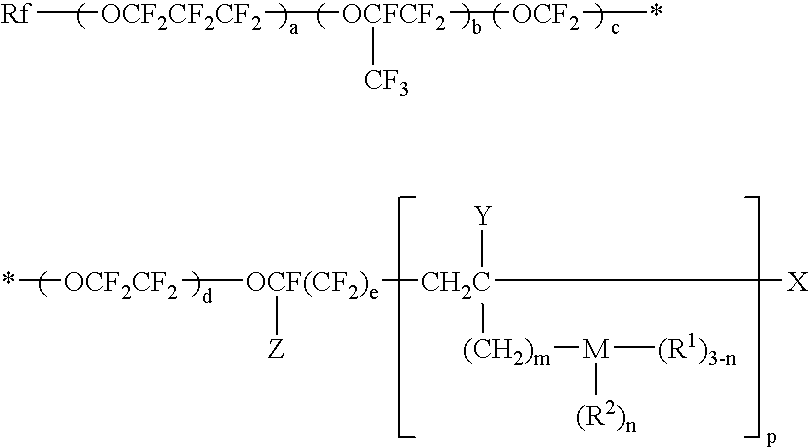Surface-treating agent comprising inorganic/organic composite material
a composite material and surface treatment technology, applied in the direction of synthetic resin layered products, instruments, transportation and packaging, etc., can solve the problems of insufficient soil releasability, low refractive index and scratch resistance of materials, and difficult vapor deposition method to form a homogeneous, etc., to achieve excellent soil releasability and transparency, excellent ant-reflective effect, and low refractive index
- Summary
- Abstract
- Description
- Claims
- Application Information
AI Technical Summary
Benefits of technology
Problems solved by technology
Method used
Image
Examples
preparation example 1
[0352]
[0353] Into a 200 mL four-necked flask equipped with a stirrer, a dropping funnel, a condenser and a thermometer, a solution of .omega.-fluoropolyperfluorooxetane iodide compound (40 g) of the formula (a):
C.sub.3F.sub.7--(OCF.sub.2CF.sub.2CF.sub.2).sub.24--O(CF.sub.2).sub.2I (a)
[0354] in hexafluorotetrachlorobutane (80 g) and di-t-butyl peroxide (1.5 g, 1.times.10.sup.-2 mol), and then the flask was sufficiently replaced with a nitrogen gas. Vinyltrichlorosilane (16.1 g, 0.1 mol) was dropwise added from the dropping funnel under nitrogen stream. After the completion of the addition, the temperature of the system was increased to 120.degree. C. to conduct the reaction for 4 hours. After the reaction, volatiles were completely distilled off under vacuum to give a silane compound having terminal iodine (38.7 g). In the same flask as the above, a solution of said silane compound (34.4 g) in perfluorohexane (50 g) was charged, zinc (2.1 g, 3.2.times.10.sup.-2 mol) was intensely di...
synthesis example 1
[0356]
[0357] Into a 100 mL four-necked flask equipped with a stirrer and a thermometer, perfluoro(1,1,9,9-tetrahydro-2,5-bistrifluoromethyl-3,6-diox-anonenol): 33
[0358] (20.4 g) and a 8.0% by weight solution (21.2 g) of
[HCF.sub.2CF.sub.2.paren close-st..sub.3COO.sub.2
[0359] in perfluorohexane were charged, the nitrogen replacement was sufficiently conducted and then the system was stirred under nitrogen stream at 20.degree. C. for 24 hours to generate a solid having a high viscosity.
[0360] A solution of the resultant solid in diethyl ether was poured into perfluorohexane, the separation was conducted, the separated matter was dried under vacuum to give a colorless transparent polymer (17.6 g).
[0361] The analysis of the polymer by a .sup.19F-NMR analysis, a .sup.1H-NMR analysis and an IR analysis revealed that the polymer was a fluoropolymer consisting of structural units of the above-mentioned fluorine-containing allyl ether and having a hydroxyl group at a side chain terminal. Acc...
preparation example 2
[0362]
[0363] After a 150 mL internal volume of a stainless autoclave equipped with an electromagnetic stirrer was sufficiently replaced with a nitrogen gas, acetone (60 g), 3-methacryloxypropyl trimethoxysilane (TMSM) (5 g), methyl methacrylate (MMA) (20 g) and dilauroyl peroxide (LPO) (0.15 g) was charged and the temperature increase was initiated. The reaction was continued at 55.degree. C. for 20 hours and then the reaction was discontinued. After the reaction mixture reached the room temperature, the resultant polymer solution was poured into methanol to precipitate the polymer. The polymer was washed with methanol and vacuum-dried at 50.degree. C. to give 21 g of an adhesion improvement agent (C); P(MMA-TMSM). According to a GPC analysis using tetrahydrofuran (THF) as a solvent, the number-average molecular weight was 9,000 and the weight-average molecular weight was 20,000.
PREPARATION EXAMPLE 3
[0364]
[0365] Into a 200 mL four-necked flask equipped with a stirrer, a dropping f...
PUM
| Property | Measurement | Unit |
|---|---|---|
| surface free energy | aaaaa | aaaaa |
| refractive index | aaaaa | aaaaa |
| surface free energy | aaaaa | aaaaa |
Abstract
Description
Claims
Application Information
 Login to View More
Login to View More - R&D
- Intellectual Property
- Life Sciences
- Materials
- Tech Scout
- Unparalleled Data Quality
- Higher Quality Content
- 60% Fewer Hallucinations
Browse by: Latest US Patents, China's latest patents, Technical Efficacy Thesaurus, Application Domain, Technology Topic, Popular Technical Reports.
© 2025 PatSnap. All rights reserved.Legal|Privacy policy|Modern Slavery Act Transparency Statement|Sitemap|About US| Contact US: help@patsnap.com



